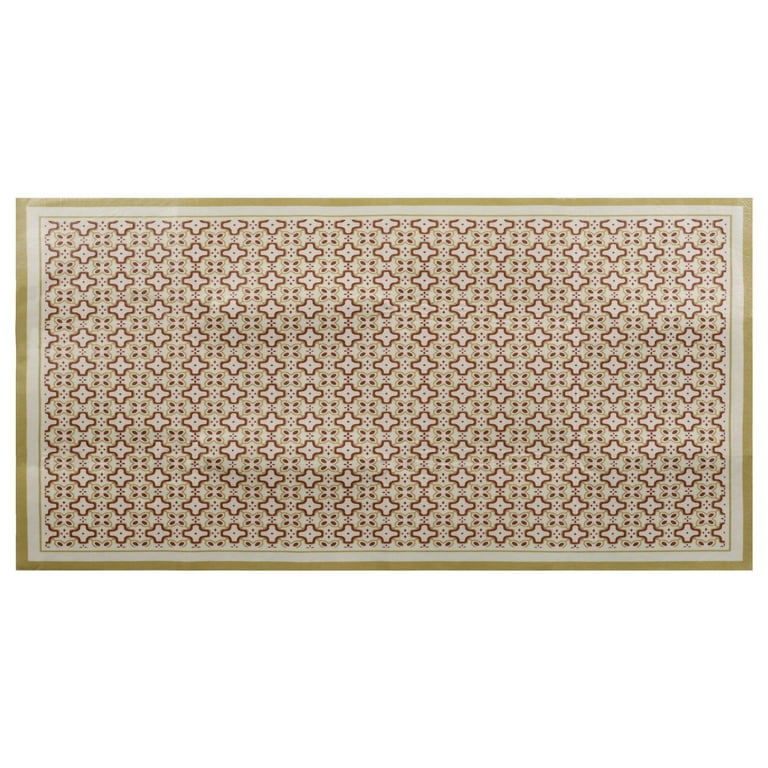When was the last time you cleaned your kitchen mat? If you can’t remember, you’re not alone.
Kitchen mats are often overlooked when tidying up. However, these humble floor protectors can harbor more dirt and germs than you’d expect. Your kitchen is the heart of your home, where meals are crafted and memories are made. Ensuring a clean environment is crucial for both hygiene and comfort.
But how often should you really be cleaning those mats underfoot? Discover the secrets to a spotless kitchen floor and learn just how much of a difference a clean mat can make in your daily life. Keep reading to find out how to keep your kitchen fresher than ever.

Credit: www.ebay.com
Importance Of Clean Kitchen Mats
Kitchen mats play a crucial role in maintaining a safe cooking environment. They provide comfort and reduce fatigue while standing. Dirty mats can become unhygienic and may cause health issues. Keeping them clean ensures a healthier kitchen space.
Regular cleaning of kitchen mats is essential. It prevents the buildup of germs and bacteria. A clean mat enhances the overall appearance of your kitchen. It contributes to a pleasant cooking experience.
Why Hygiene Matters
Food particles often fall onto kitchen mats. These particles can attract pests and bacteria. A dirty mat can be a breeding ground for germs. Regular cleaning helps in maintaining hygiene standards. It ensures a safer cooking environment.
Impact On Kitchen Aesthetics
A clean mat enhances kitchen aesthetics. It complements the overall decor. Dirty mats can make the kitchen appear untidy. Regular cleaning keeps mats looking fresh and new. It adds charm to your cooking space.
Reducing Slip Hazards
Grease and spills can make mats slippery. A clean mat reduces slip hazards. It provides a stable surface to stand on. Regular cleaning removes residues. This helps in ensuring safety while cooking.
Prolonging Mat Lifespan
Frequent cleaning can extend mat lifespan. Dirt and grime can degrade mat quality. Proper maintenance keeps mats in good condition. It prevents wear and tear. This saves money on replacements.
Factors Affecting Cleaning Frequency
Kitchen mats need regular cleaning based on usage, foot traffic, and spill frequency. High-traffic kitchens require more frequent cleaning to maintain hygiene. Spills and stains demand immediate attention to prevent bacteria build-up.
Cleaning your kitchen mats might seem like a straightforward task, but how often do you really need to do it? The answer depends on several factors. Understanding these can help you maintain a cleaner, healthier kitchen environment without overdoing it. Let’s dive into the details that influence how often you should clean your kitchen mats.Usage Intensity
How often do you and your family gather in the kitchen? If your kitchen is the heart of your home, with constant foot traffic during meal prep and gatherings, your mats will need more frequent cleaning. On the other hand, a kitchen used sparingly might allow for longer intervals between cleanings. Think of your kitchen mats as silent witnesses to your culinary adventures. The more spills and crumbs they see, the more attention they need. Regular users might find a weekly or bi-weekly wash necessary.Type Of Material
The material of your kitchen mats plays a crucial role in determining cleaning frequency. Mats made from natural fibers like cotton or bamboo may require more frequent cleaning due to their absorbent nature. Synthetic materials, designed to repel moisture and stains, can often go longer without a wash. Consider your mat’s material carefully. Is it machine washable, or does it require special care? Knowing this can save you time and effort in the long run, while keeping your kitchen fresh and inviting.Kitchen Environment
The overall environment of your kitchen also impacts how often you should clean your mats. If your kitchen tends to be humid, mats can become breeding grounds for mold and mildew if not cleaned regularly. Similarly, kitchens that are prone to grease and oil splatters might require more frequent cleaning. Ask yourself, does your kitchen have good ventilation? Do you often cook meals that create greasy splatters? Answering these questions can help you set a practical cleaning schedule that keeps your kitchen mats in top condition. In your experience, have you ever noticed an unexpected stain or odor just when guests were about to arrive? Keeping track of these factors will ensure such surprises become a thing of the past. By understanding the unique needs of your kitchen, you can maintain a cleaner, more welcoming space without unnecessary hassle.Recommended Cleaning Schedule
Kitchen mats should be cleaned weekly to maintain hygiene. Regular washing removes dirt, spills, and bacteria. For high-traffic areas, consider cleaning more frequently to ensure a clean and safe kitchen environment.
Keeping your kitchen mats clean isn’t just about appearances; it’s about maintaining hygiene and extending their lifespan. If you’ve ever spilled milk or dropped a sticky spoon on your mat, you know how quickly they can become a hotspot for bacteria. This is why a recommended cleaning schedule is essential. It ensures your mats remain fresh, safe, and welcoming every day.Daily Spot Cleaning
Daily spot cleaning is your first line of defense against stains and odors. You might ask, “Do I really need to clean my mat every day?” Think about how much you use it. With all the cooking and foot traffic, it’s likely your mat sees more spills than you’d like. Quickly wiping away spills with a damp cloth can prevent stains from setting in. This routine doesn’t take much time and can save you from more intense scrubbing later. Consider it like brushing your teeth—small efforts daily prevent bigger problems down the road.Weekly Deep Clean
A weekly deep clean is crucial to remove dirt and bacteria that accumulate over time. You know those days when you have a few extra minutes after dinner? That’s the perfect time to roll up your sleeves and give your mat a good clean. Use a mild detergent and warm water. Scrub gently with a brush to remove any stubborn dirt. Rinse thoroughly and allow it to dry completely before putting it back. Have you noticed how refreshing it feels to step on a freshly cleaned mat? That’s the reward for your efforts!Monthly Maintenance
Monthly maintenance is all about the little things that make a big difference. You might think, “I cleaned my mat last week, why do I need to do more?” Well, monthly maintenance includes checking for wear and tear. Look for any frayed edges or areas that need repair. This is also the time to evaluate whether your cleaning products are effective. Are they leaving residue or causing fading? Adjust accordingly to keep your mats in peak condition. Taking these steps ensures your mats remain both functional and aesthetically pleasing. So, how do you plan to integrate these cleaning habits into your routine?
Credit: www.walmart.com
Effective Cleaning Techniques
Kitchen mats should be cleaned weekly to prevent dirt buildup. Regular cleaning maintains hygiene and extends their lifespan. Use mild detergent and warm water for effective results.
Keeping your kitchen mats clean not only enhances the aesthetic of your kitchen but also ensures hygiene and safety. Mats can trap dust, food particles, and moisture, making them prime spots for bacteria and allergens. Regular cleaning keeps them in good shape and extends their life. So, how can you effectively clean your kitchen mats? Let’s dive into some practical techniques to maintain them effortlessly.Vacuuming And Shaking
Vacuuming your kitchen mats is a quick and easy way to remove loose dirt and debris. Use the vacuum’s brush attachment for best results. It helps lift dirt embedded in the fibers. Shake your mats outside at least once a week. This simple action releases crumbs and dirt that aren’t picked up by the vacuum. It’s a fast way to refresh your mats without needing any tools.Machine Washing
If your mat is machine washable, toss it in the washer for a deeper clean. Use a gentle cycle with cold water to protect the mat’s material. Avoid using bleach as it can damage the fabric. Add a small amount of mild detergent to the wash. This ensures the mat is thoroughly cleaned without any harsh chemicals that can wear it down. Always air dry your mats to prevent shrinking.Hand Washing Tips
For mats that can’t be machine washed, hand washing is a viable option. Fill a basin with warm water and a few drops of mild detergent. Use a soft brush or cloth to gently scrub the mat. Rinse thoroughly to remove soap residue, which can attract more dirt if left behind. Hang the mat to dry in a well-ventilated area to avoid any musty smells. Cleaning your kitchen mats regularly might seem like a chore, but it pays off with a fresher, safer kitchen environment. Have you ever considered how often you step on your kitchen mat daily? Keeping them clean will make each step feel a little bit better.Choosing The Right Cleaning Products
Keeping your kitchen mats clean is crucial for maintaining a healthy and welcoming cooking environment. The right cleaning products can make this task easier and more effective. But with so many options available, how do you know which ones to choose? Let’s explore different cleaning solutions to keep your kitchen mats fresh and spotless.
Eco-friendly Options
Choosing eco-friendly cleaning products is not only good for the environment but also for your home. These products are typically made from natural ingredients, reducing the risk of harmful chemicals lingering on your mats. You can find eco-friendly cleaners at most grocery stores, or you might even have some effective options already at home, like vinegar or baking soda.
Have you ever tried using vinegar to clean your mats? It’s surprisingly effective! Simply mix equal parts of water and vinegar, spray it on the mat, and wipe it down. This solution is gentle yet powerful enough to remove grime and bacteria.
Chemical Cleaners
Chemical cleaners can offer a quick and strong solution for tough stains and dirt. Products like bleach or all-purpose cleaners are popular for their ability to tackle stubborn grime. However, they should be used with caution to avoid damaging your mats or affecting your indoor air quality.
Always read the label before using a chemical cleaner. Some mats may have specific instructions or warnings about the types of cleaners that are safe to use. Have you ever noticed a bleach stain on a favorite item? It’s a reminder to check those labels and test cleaners on a small area first.
How often do you clean your kitchen mats? The frequency might depend on how often you cook or spill. No matter your routine, choosing the right cleaning products can make the task less of a chore and more of a habit that benefits your home.
Extending The Lifespan Of Kitchen Mats
Kitchen mats need cleaning every week to prevent germs and stains. Regular washing helps maintain their appearance. A clean mat enhances kitchen hygiene and extends its lifespan.
Extending the lifespan of your kitchen mats is not just about regular cleaning. It’s about smart maintenance and care practices. You might have noticed that your kitchen mats start looking worn out after a few months, even with consistent cleaning. This can be frustrating. But by adopting a few simple habits, you can keep them looking fresh and functional for much longer.Proper Drying Methods
Wet mats can quickly become a breeding ground for bacteria and mold. After washing your kitchen mats, ensure they dry completely. Hang them in a well-ventilated area or lay them flat in the sun to speed up drying. Avoid putting them back on the floor while they’re still damp. This habit not only protects your mat but also your kitchen floor. In humid climates, consider using a fan or a dehumidifier to aid the drying process.Storage Tips
If you rotate your kitchen mats or have seasonal ones, how you store them matters. Roll them rather than folding to prevent creases. Those creases can damage the material over time. Use storage bins to keep them dust-free when not in use. If you have limited space, consider vacuum-sealed bags. These can compress the mats, saving space while keeping them clean. Think about the last time you stored something properly. Did it last longer? The same principle applies to your kitchen mats. Proper storage can significantly extend their lifespan.Signs Your Kitchen Mat Needs Replacement
Kitchen mats with stains or odors might need replacement. Regular cleaning every two weeks keeps them fresh. Mats should be replaced if they have fraying edges or lose cushioning.
Signs Your Kitchen Mat Needs Replacement Kitchen mats are essential for comfort and safety. Over time, these mats can show signs of wear, reducing their effectiveness. Knowing when to replace them ensures your kitchen remains safe and pleasant.Wear And Tear Indicators
Check your mat’s surface regularly. Look for fraying edges or thinning areas. These signs mean the mat is losing its cushioning. Notice any curling corners? This can cause tripping hazards. A mat that feels less supportive may need replacement. Inspect for any holes or tears. These can trap dirt and germs, making cleaning difficult.Persistent Stains
Some stains refuse to go away. These can affect the mat’s appearance and hygiene. Even after cleaning, if stains remain, it might be time for a new mat. Stubborn stains can harbor bacteria. This is especially concerning in the kitchen area. Fading colors are another indicator. A mat that looks dull or discolored may not match your kitchen’s style. Regular cleaning should remove stains. If it doesn’t, consider replacing the mat.
Credit: www.amazon.com
Frequently Asked Questions
How Often Should Kitchen Mats Be Washed?
Kitchen mats should be washed every two weeks to maintain hygiene. Regular cleaning prevents the build-up of dirt and bacteria. If your kitchen sees heavy usage, consider cleaning them weekly. Always follow manufacturer instructions for best results, especially with special materials or designs.
Can Kitchen Mats Be Machine Washed?
Most kitchen mats can be machine washed, but check the label first. Use a gentle cycle with cold water to prevent damage. Avoid using bleach unless specified. Air drying is preferred over using a dryer to maintain the mat’s integrity and longevity.
Are Kitchen Mats Safe For Hardwood Floors?
Kitchen mats can be safe for hardwood floors if they have a non-slip backing. Ensure the mat is made of materials that won’t scratch or discolor the floor. Regularly check for moisture underneath to prevent damage. Choosing mats specifically designed for hardwood can offer additional protection.
Do Kitchen Mats Help Reduce Fatigue?
Yes, anti-fatigue kitchen mats can help reduce fatigue. They provide cushioning for your feet and support your posture. This can make standing for long periods more comfortable. These mats are especially beneficial in areas where you cook or wash dishes frequently.
Conclusion
Keeping kitchen mats clean is simple yet essential. Regular cleaning prevents dirt build-up. It also extends the mat’s lifespan. Weekly cleaning suits most homes. High traffic areas may need more frequent attention. Quick vacuuming or shaking helps. Spot cleaning tackles stains effectively.
Choose mild soap and warm water for a thorough clean. Dry mats completely before use. This stops mold growth. Clean mats not only look good but also ensure safety. A tidy kitchen mat means a happier kitchen space. Prioritize cleanliness for a healthier home environment.
Stay consistent, and your kitchen mats will thank you!

As the chief content writer, Hassan Al Sarker works as a professional kitchen-based content creator at Kitchen Liker.
In addition to reviewing the content published on Kitchen Liker, he ensures that it is accurate, relevant, and helpful. As a result, all the reviews and information published at Kitchen Liker are neutral and userfriendly.
Hassan Al Sarker has a bachelor’s degree in Hotel and Tourism Management From the Newyork University. Before joining Kitchen Liker, he was a contributor at Kitchen Club, United States.

